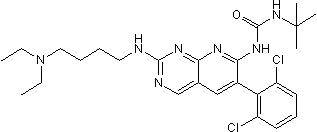FGFR1-4: Small Molecules and Peptides
FGF activity is mediated by a family of type I transmembrane tyrosine kinases, which undergo dimerization and autophosphorylation after ligand binding. Five distinct genes encode closely related FGF receptors, FGFR1 through 5. FGFRs contain three Ig-like domains and a stretch of acidic residues between the first and second Ig-like domains. FGFR1, 2, 3, and -4 have a cytoplasmic split tyrosine-kinase domain, but FGFR5 does not. Multiple forms of FGFR1, 2, and 3 are generated by alternative splicing.
Products:
2 results for "FGFR1-4 Small Molecules and Peptides" in Products
2 results for "FGFR1-4 Small Molecules and Peptides" in Products
FGFR1-4: Small Molecules and Peptides
FGF activity is mediated by a family of type I transmembrane tyrosine kinases, which undergo dimerization and autophosphorylation after ligand binding. Five distinct genes encode closely related FGF receptors, FGFR1 through 5. FGFRs contain three Ig-like domains and a stretch of acidic residues between the first and second Ig-like domains. FGFR1, 2, 3, and -4 have a cytoplasmic split tyrosine-kinase domain, but FGFR5 does not. Multiple forms of FGFR1, 2, and 3 are generated by alternative splicing.
Products:
Potent FGFR and VEGFR inhibitor
| Alternate Names: | PF-02969207,PNU-0290908 |
| Chemical Name: | 2-[(1,2-Dihydro-2-oxo-3H-indol-3-ylidene)methyl]-4-methyl-1H-pyrrole-3-propanoic acid |
| Purity: | ≥95% (HPLC) |
Selective FGFR inhibitor
| Chemical Name: | N-[6-(2,6-Dichlorophenyl)-2-[[4-(diethylamino)butyl]amino]pyrido[2,3-d]pyrimidin-7-yl]-N'-(1,1-dimethylethyl)urea |
| Purity: | ≥97% (HPLC) |


